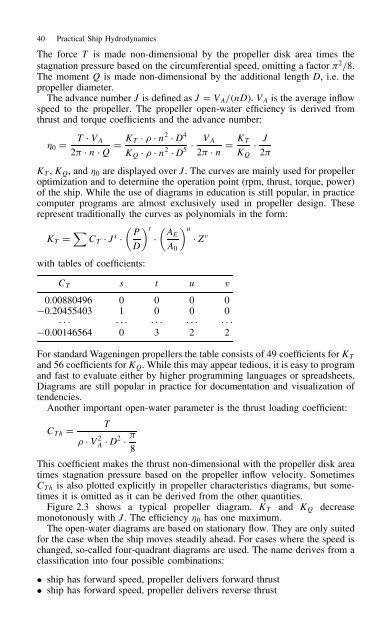Practical Ship Hydrodynamics
Practical Ship Hydrodynamics
Practical Ship Hydrodynamics
Create successful ePaper yourself
Turn your PDF publications into a flip-book with our unique Google optimized e-Paper software.
40 <strong>Practical</strong> <strong>Ship</strong> <strong>Hydrodynamics</strong><br />
The force T is made non-dimensional by the propeller disk area times the<br />
stagnation pressure based on the circumferential speed, omitting a factor 2 /8.<br />
The moment Q is made non-dimensional by the additional length D, i.e.the<br />
propeller diameter.<br />
The advance number J is defined as J D VA/⊲nD⊳. VA is the average inflow<br />
speed to the propeller. The propeller open-water efficiency is derived from<br />
thrust and torque coefficients and the advance number:<br />
T Ð VA<br />
0 D<br />
2 Ð n Ð Q D KT Ð Ð n 2 Ð D 4<br />
KQ Ð Ð n 2 VA KT<br />
Ð D Ð 5<br />
Ð D 2 Ð n KQ<br />
J<br />
2<br />
KT, KQ, and0 are displayed over J. The curves are mainly used for propeller<br />
optimization and to determine the operation point (rpm, thrust, torque, power)<br />
of the ship. While the use of diagrams in education is still popular, in practice<br />
computer programs are almost exclusively used in propeller design. These<br />
represent traditionally the curves as polynomials in the form:<br />
KT D � CT Ð J s Ð<br />
� P<br />
D<br />
with tables of coefficients:<br />
� t<br />
Ð<br />
� �u AE<br />
A0<br />
Ð Z v<br />
CT s t u v<br />
0.00880496 0 0 0 0<br />
0.20455403 1 0 0 0<br />
ÐÐÐ ÐÐÐ ÐÐÐ ÐÐÐ ÐÐÐ<br />
0.00146564 0 3 2 2<br />
For standard Wageningen propellers the table consists of 49 coefficients for KT<br />
and56coefficientsforKQ. While this may appear tedious, it is easy to program<br />
and fast to evaluate either by higher programming languages or spreadsheets.<br />
Diagrams are still popular in practice for documentation and visualization of<br />
tendencies.<br />
Another important open-water parameter is the thrust loading coefficient:<br />
CTh D<br />
T<br />
Ð V 2 A Ð D2 Ð<br />
8<br />
This coefficient makes the thrust non-dimensional with the propeller disk area<br />
times stagnation pressure based on the propeller inflow velocity. Sometimes<br />
CTh is also plotted explicitly in propeller characteristics diagrams, but sometimes<br />
it is omitted as it can be derived from the other quantities.<br />
Figure 2.3 shows a typical propeller diagram. KT and KQ decrease<br />
monotonously with J. The efficiency 0 has one maximum.<br />
The open-water diagrams are based on stationary flow. They are only suited<br />
for the case when the ship moves steadily ahead. For cases where the speed is<br />
changed, so-called four-quadrant diagrams are used. The name derives from a<br />
classification into four possible combinations:<br />
ž ship has forward speed, propeller delivers forward thrust<br />
ž ship has forward speed, propeller delivers reverse thrust
















